





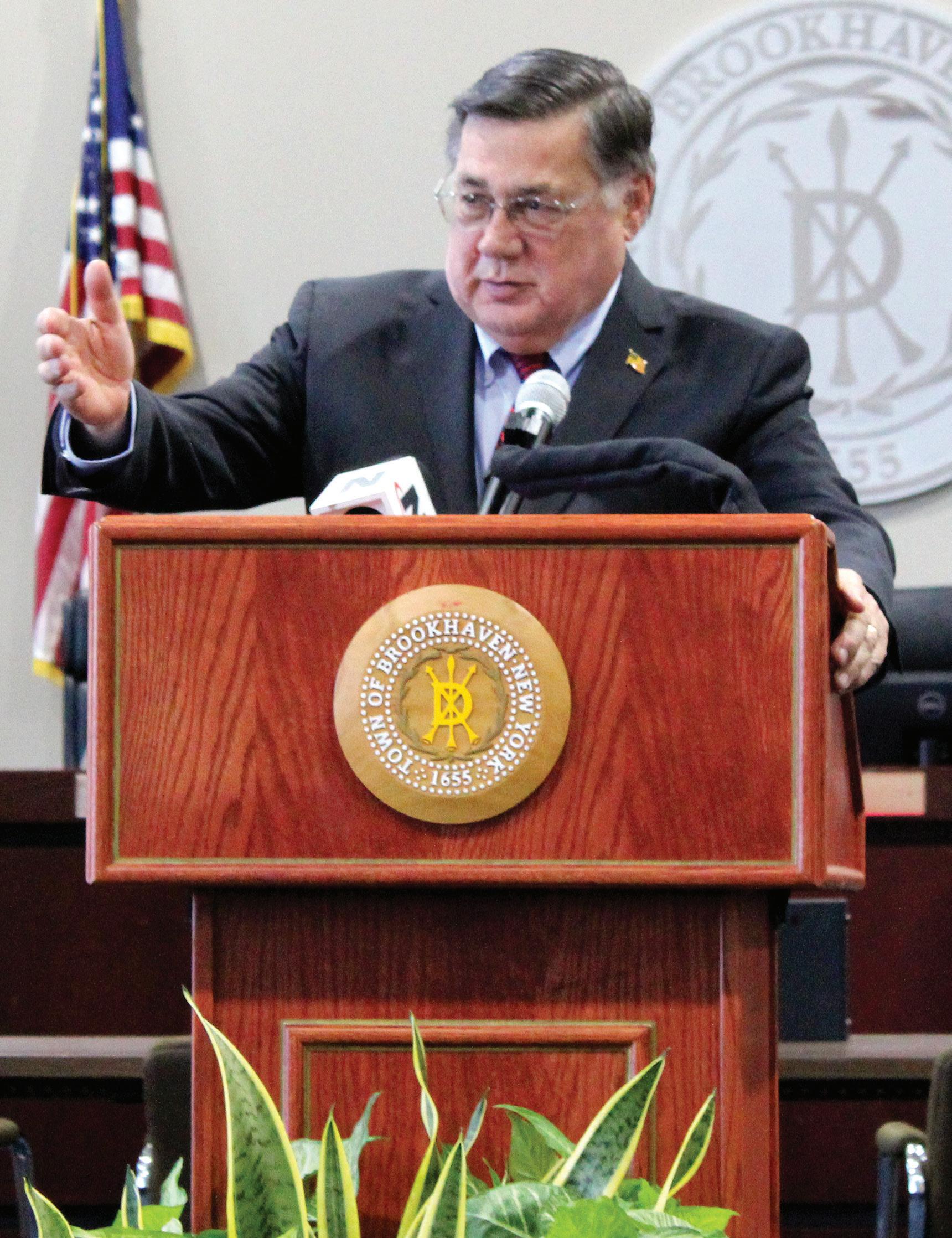 By Matt Meduri
By Matt Meduri
In a new case that has shaken Long Island, human remains were found across Babylon Township and Bethpage State Park. The victims, who have not been identified, are presumed to be a 53-year-old man and a 59-yearold woman.
The first remains were found last Thursday, February 29, by high school students walking to school. They discovered the man’s arm on the side of Siegel Boulevard near Southards Pond Park in North Babylon. Both arms were found in the east side of the park, while the woman’s head, left leg, right leg, and right arm were found on the west side of the park just hours later. The woman’s remains were near Babylon Elementary School.
More remains were found Tuesday in the woods near Lakeway Drive in West Babylon, three miles from Southards Pond Park. More remains were then discovered in Bethpage State Park.
Police then identified suspects living in a shared home in Amityville, where “sharp instruments, multiple body parts, and other related items”
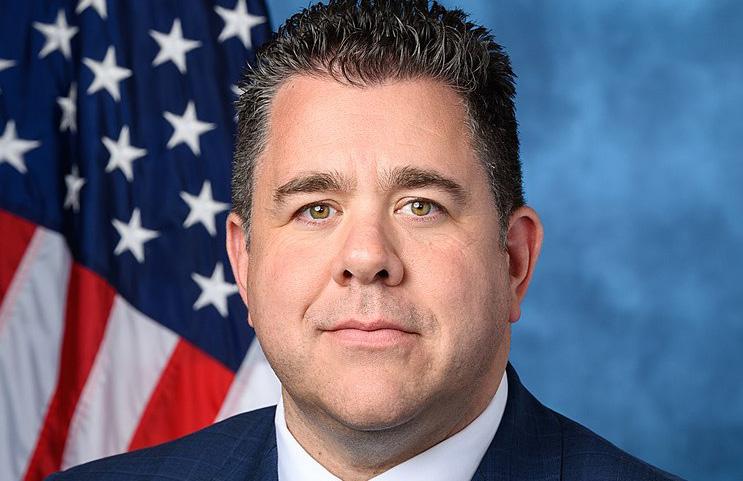
were found. Police say that the suspects “dispose[d] of them to conceal the crime of murder in the second degree.”
Four people have been charged with concealing a human corpse and tampering with evidence. Steven Brown, 44, Amanda Wallace, 40, Jeffrey Mackey, 38, and Alexis Nieves, 33, were charged with first-degree hindering prosecution, tampering with physical evidence by concealing or destroying, and concealment of a human corpse.
All have pleaded not guilty.
Brown, Wallace, and Mackey all live in Amityville, while Nieves is said to be homeless. The relationship between the suspects have not been explained, nor have a connection to victims or a motive for possible murder been established.
Suffolk homicide detectives allege that the suspects “did conceal, alter, and destroy human body parts” and that the “dismembered body parts were removed” from the home and “concealed at multiple known locations.”
Continued on page 3













Suffolk County District Court, Assistant District Attorney Frank Schroder of the Homicide Bureau said that police have obtained damning evidence against the four, including the human remains, meat cleavers, butcher knives, large amounts of blood, as well as video surveillance.
The four defendants have been released without bail. They have been ordered to surrender their passports, not leave Suffolk County, and report to probation weekly. All have been issued GPS monitoring devices.
The defendants’ attorneys have assumed their clients’ innocence, with Brown’s attorney, Ira Weissman, saying that his client “certainly didn’t kill anybody.”
The conversation now turns to the long-controversial topic of bail reform in New York State. Pursuant to a set of criminal justice overhauls championed by then-Governor Andrew Cuomo (D), and upheld by the Democrat-dominated state legislature and Governor Kathy Hochul (D), certain offenses are no longer considered bail eligible.
All four suspects have been granted supervised release, instead of detention or a requirement to post bond.
Suffolk County District Attorney Ray Tierney (R) railed against the laws in response to this particular case.
“It is our understanding that the Suffolk County Police Department is still investigating these murders,” said Tierney. “Unfortunately, due to ‘Bail Reform’ passed by the New York State Legislature in 2019, charges relating to the mutilation and disposal of murdered corpses are no longer bail-eligible,
meaning my prosecutors cannot ask for bail. This is yet another absurd result thanks to ‘Bail Reform’ and a system where the Legislature in Albany substitutes their judgment for the judgment of our judges and the litigants in court. We will work with the Suffolk County Police Department to resolve this investigation as soon as possible and implore our Legislature to make common sense fixes to this law.”
Suffolk County Executive Ed Romaine (R-Center Moriches) also weighed in on the “The failure of Albany’s Bail Laws has resulted in those charged with dismembering and placing body parts in our communities to walk free without posting any bail,” said Romaine. “This is outrageous, and completely unacceptable in a civilized society, when our prosecutors are handcuffed and those charged with this heinous crime are mandated by the state to go free. Despite the incredible work by the Suffolk County Police Department and our District Attorney Ray Tierney the failed 2019 NYS Bail Laws continue to put the public at risk. These laws must be changed immediately, and I will support the law enforcement community in any efforts to force change in Albany to make Suffolk County a safer place to live.”
The laws continue to earn criticism from law enforcement and the general public, especially as high-profile cases such as these are affected by the reforms.
While the suspects are on supervised release, they cannot return to the Amityville residence on Railroad Avenue off of Route 110, as police removed and destroyed some of the plumbing in the investigation.






The William Merritt Hallock American Legion Post No. 155 115 Church Street Lake Ronkonkoma, NY Is
We meet at the Post twice a month1st Tuesday of the month at 1:00 pm and the 3rd Tuesday of the month at 7:00 pm.
We have a social hour with snack one hour prior to the meeting. Our meetings generally run about one hour. We take part in our local community parades and street fairs. We usually have three social functions with family and friends each year. We participate in a number of patriotic ceremonies. If interested in joining our Post and meeting some fellow veterans, stop by on a meeting day with a copy of your DD214.
You can visit our website at: AmericanLegionWilliamHallockPost155.org
This question has been asked ad nauseum since Albany decided to enact these disastrous changes in 2019. Under the guise of social justice and criminal justice reform, then-Governor Andrew Cuomo (D) and the Democrat-run State Legislature passed a comprehensive overhaul of how New York handles prosecutive and general criminal justice. The most notable change was that of bail requirements, in which a slew of offenses remove prosecutors’ abilities to remand criminals and require a cash bond or bail for release. The law also removes much of judges’ discretion in holding criminals who may pose a threat to the community or might be a flight risk.
Albany’s logic in making these changes was that low-level or first-time offenders may or may not be further negatively affected by the criminal justice system in the event they cannot afford to post bail. The accusation by Albany is that the criminal justice system becomes pay-to-play, wherein more affluent offenders can post bail, while poorer offenders have to suffer the consequences of being jailed. Albany further connected this idea with the fact that some of the less fortunate offenders are of lower socioeconomic status, which the left inevitably connects to race. In short, their argument is that the criminal justice system was systemically and intrinsically oppressive, and the solution was to abolish the retention of criminals on cash bail to even the playing field.
What resulted, not to the shock of many, was a revolving-door criminal justice system, wherein criminals can continue to offend at their leisure instead of being held. While we won’t argue that there might be some aspects of “pay-to-play” involved in any criminal justice system, the risk is simply not worth the reward. There can be creative ways of punishing affluent offenders without risking the well-being, peace, or even lives of the general public with these illogical bail reform changes.
The other problem is that the bail reform changes do not only apply to low-level charges. In the wake of the recent discoveries of human remains scattered across the Town of Babylon, the loopholes of these reforms are fully unearthed. All four suspects charged with tampering with evidence and concealment of a human corpse were released on supervision with GPS ankle monitors and were forced to surrender their passports.
Sure, they’re being tracked and they can’t go anywhere. When have rules and laws ever fully prevented any unwanted behavior?
But if you’re a rational person, the top thought on your mind is probably:
“Why are people guilty of concealing a human corpse and tampering with evidence not being detained?”
We’d like to toast you for reaching such a conclusion that Albany has apparently not been able to make for almost five years.
But that’s just the knee-jerk response. It gets even worse when the police say the suspects removed meat cleavers, butcher knives, and significant amounts of blood from their Amityville residence. There seems to be substantial evidence that they butchered the body in-house.
While the suspects have not been charged in the murders of the victims, we wouldn’t chastise you for assuming they had a hand in it. We’re not alleging these four are also murderers, but these are questions that need to be asked when such people are simply released back onto the streets.
Furthermore, the bail reform laws significantly kneecap police and prosecutors’ abilities to do their jobs, something many of our elected and community officials have echoed since these laws were passed in 2019. It stymies the ever-effective and valiant efforts of our District Attorney Ray Tierney, whose monumental breakthroughs in the Gilgo Beach murdersconveniently, also in Babylon - have proven his and his office’s abilities to crack cold cases of the highest degree. We understand checks and balances on power are necessary, but why take away the most basic tools prosecutors, law enforcement, and judges use to gauge the potential safety of a community based on the defendants who are brought in?
We do not doubt Tierney’s abilities in handling this case, nor do we doubt the Suffolk County Police Department’s abilities to further investigate this. Who we do not have faith in, if it even needs to be said, is the State Legislature. They either know exactly what they’re doing and are deliberately contributing to a society ruled by chaos, or they are just truly inept and are so haughty in their ways that they can’t even pump the brakes a little bit.
They have no prerogative in the former and no excuse in the latter. Officials have made it clear the disastrous consequences these laws would have even before their passage. They have spared no expense in the last five years rightfully decrying the monumentally out-of-touch nature of these reforms and the politicians who penned them.
We continue to hold out hope that common sense will return to Albany someday, but until then, it seems it’s almost every man - or county - for himself.
The migrant crisis continues its grip on New York State and the country as a whole as crimes committed by illegal immigrants grip communities in fear and inspire legislation across the United States.
As we’ve heard before: “Every state is a border state, every county is a border county.” Elected officials in New York have learned this the hard way by biting off more than can chew and promising the world when they already regularly underdeliver for their constituents.
But above the financial and logistical strains of mass importing people who lay dubious claims to true asylum comes the obvious Trojan Horse of criminals, drug kingpins, human traffickers, and even terrorists quite literally invading both borders of our nation. Not only are most migrants from South and Central America military-age men, but we’ve also seen immigrants from Haiti, China, the Middle East, and dozens of other countries appear at the southern border. What could possibly be drawing the entire world to the porous line in the sand that continues to go unenforced?
New York State legislators have introduced multiple bills to fight this crisis, with one introduced by Islip’s very own Jarett Gandolfo (R-Sayville) requiring New York State to require Immigration and Customs Enforcement (ICE) of arrests or convictions of non-citizens.
But the unfettered immigration and uncontrolled border have long been chronically responsible for unnecessary violent crimes and deaths to U.S. citizens. This isn’t to say that citizens who commit identical crimes should be treated with kid gloves, but handling the current crime epidemic would be much easier if we didn’t stack our plate with additional, highly-preventable offenses.
The latest tragedy comes in the death of Laken Riley, a twenty-two-yearold nursing student at the University of Georgia. She was murdered by twenty-six-year-old Venezuelan immigrant Jose Antonio Ibarra while she was out on a run on the campus on February 22. Ibarra was arrested in Queens in 2022 on a charge of acting in a manner to injure a child less than 17, but was released thereafter before ICE could lobby for him to be taken into federal custody. New York officials said on Sunday that they had no
record of the arrest.
Ibarra was also cited for misdemeanor shoplifting in Georgia in October 2023, as was his brother, Diego.
Ibarra is said to have taken Riley to a remote location where she died of blunt force trauma. Authorities say her skull was “significantly disfigured.”
Someone like Ibarra should have been under the eye of federal immigration authorities and not so carelessly unmonitored by New York. New York State’s status as a “sanctuary state” and New York City’s status as a “sanctuary city” are said to have helped keep Ibarra out of the federal magnifying glass.
Because of our horribly mismanaged border and our tone-deaf and pathologically altruistic state leaders, a young woman was wantonly murdered for no reason at the hands of someone who, by all accounts, should not have been here.
We stand for legal immigration practices and immigration to this great country. But we should not be a doormat for the world’s worst.
If New York Democrats truly believe in amending what they call a “systemically oppressive” criminal justice system, as they have when enacting the “Bail Reform” laws, then it would make sense for them to support immigration reform, ending “sanctuary state” and “city” status in New York, and cooperating with federal authorities to stop the bleeding where we can and focus on similarly violent and incorrigible offenders our own country produces.
New York State needs to pass “Laken’s Law,” which would allow New York law enforcement to cooperate with Immigration and Customs Enforcement (ICE), effectively ending this long and illogical period of “sanctuary state” and “city” statuses that have plagued New York longer than most would care to admit.
Additionally, the U.S. House needs to pass the pending legislation “The Laken Riley Act,” sponsored by Congressman Mike Collins (R, GA-10), which would require federal authorities to detain undocumented migrants charged with theft in the United States.
We Americans find ourselves faced with the disquieting specter of a national debt measured in trillions of dollars: a sum truly inconceivable. Many economists and politicians tell us this debt portends a disastrous financial collapse in the future and we worry. Once debt free, we are now the largest debtor nation in the world and as we find ourselves on the precipice we are confounded as to how we got there.
For answers, however, we need look no further than the Farewell Address of our first President, George Washington, who, in reference to our constitution, warned:
“Let there be no change [in the Constitution] by usurpation. For though this, in one instance may be the instrument of good, it is the customary weapon by which free governments are destroyed. The precedent must always greatly overbalance in permanent evil any partial or transient benefit which the use can at any time yield.”
Change in the Constitution by usurpation? When did that happen? It happened in 1937!
Few Americans realize that up until 1937, the Congress of the United States conducted its business within the boundaries of seventeen enumerated powers granted under Article I, Section 8 of the United States Constitution. These powers defined clearly the areas of national purposes over which Congress could enact legislation including the allocation of funds and levying of taxes.
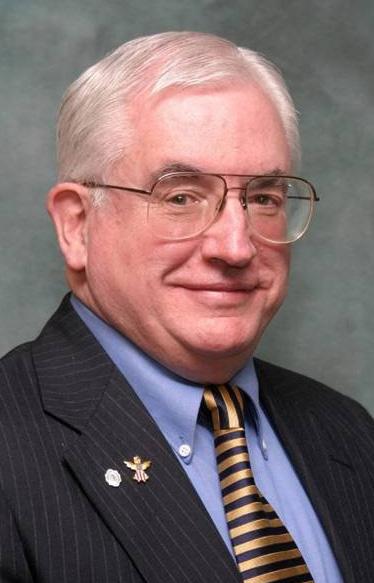
Anything not set down in the enumerated powers was considered outside the purview of the national government and hence, a matter for the states. There were occasional challenges to the concept but it was not until Franklin Roosevelt’s New Deal that it was attacked in deadly earnestness.
Ill winds prevailed against the Constitution in the 1930s. The country was in the Great Depression and Franklin D. Roosevelt asked for extraordinary “powers similar to those necessary in time of war,” to meet the emergency. Poorly crafted legislation, some of it not printed in time for floor vote, was rammed through a docile and Compliant 73rd Congress. Everything he asked for was given, with little or no debate.
The first of the New Deal statutes to reach the Supreme Court for review arrived in January 1935. In the sixteen months following, the Court decided ten major cases or groups of cases involving New Deal statutes. In eight instances out of ten, the decisions went in favor of the United States Constitution and against the New Deal. Eight of the ten pieces of “must legislation” were found to be unconstitutional.
The President reacted:”We have therefore reached the point as a nation where we must take action to save the Constitution from the Court and the Court from itself.”
The President declared war on the Supreme Court.
To appreciate the depth of FDR’s resolve in such issues, one need only read his correspondence to Representative Snyder of Pennsylvania asking Congress to pass the National Bituminous Coal Conservation Act regardless of any doubts, “however reasonable,” that it might have about the bill’s Constitutionality. It appeared in this case at least, the President was urging Congress to disregard the Constitution.
Constitutional historians refer to what happened next as the “Revolution of 1937.” The President proposed that for each sitting Justice over the age of seventy be appointed one new Justice to “help them with their caseload.” In reality, FDR wanted to pack the court with six additional justices willing to declare all of his “must legislation” Constitutional.
Chief Justice Hughes was traumatized. He looked for a way to disengage the President’s plan which appeared almost certain to pass both chambers and be signed into law. What to do? What was about to happen would ultimately lead our country to the clear and present danger of economic insolvency.
The Supreme Court at the time consisted of four conservatives, three liberals, one moderate, and one swing. The moderate was Hughes. The swing was Roberts. Hughes prevailed on Roberts to desert the Conservative camp, swing over with him and join the three liberals in declaring the Social Security cases Constitutional.
By doing so, Roberts took the wind from the sails of Roosevelt’s plan to “pack” the Supreme Court. The court-packing plan then went back to committee and died. One administration official dubbed the court’s action, “the switch in time that saved nine.” This decision said in effect, Congress would no longer be held to enumerated powers but instead could tax and spend for anything; so long as it was for “general welfare.”
However, the words “General Welfare” in the introduction to the enumerated powers of Article I, Section 8 were never intended to be an object for extension of the power to tax and spend.
Justice Roberts, writing in 1951, said in effect: “We voted against the Constitution to save the Court.”
Until Lyndon B. Johnson assumed the presidency, the American people’s demands on government were modest and for the most part the government lived within its means. But LBJ and his cohorts, both Democrats and moderate Republicans, said in effect, “damn the enumerated powers, full speed ahead.”
Something for everyone: spend now, pay later.
As time went on, elected representatives in Washington found it virtually
impossible to say no to constituent demands. Many of the demands were for good things. [It seemed so, if someone else paid the bill]. Most, if not all, of these things are best left to the states, regional authorities, voluntary agencies, and, yes, families. [In terms of sheer economic efficiency, nothing in all of history ever equalled the family. Whatever happened to them?]
Fifty legislative debates on the merits and uses of taxpayers dollars for local purposes is very healthy. Our founding fathers believed in the idea and we practiced it, almost perfectly until 1965. This gave great power and strength to our country. People retained more than 80% of their wages, whereas today they are left with less than 50% and many of us find ourselves reduced to asking the general government for this or that.
Consider the national debt approaching thirty-four trillion dollars. How did this happen? A “General Welfare Congress” [session after session] made this happen. With no limits on their taxing and spending power, they became like children in a candy store. Study the national debt and mandatory program curves; following full implementation of the “Great Society,” both trends begin to rise exponentially!
The two national parties must share blame for the enormous catastrophe befalling our country and its posterity.
It’s really a “Catch 22”. You want to serve your country. To serve your country, you must be in power [in Congress]. To be in power, you must be re-elected. To be re-elected, you must out-promise your opponent. To out-promise your opponent, you must promise to spend for the “General Welfare.”
And it will go on and on and on, forever, until one of three things happen:
First, adopt good moral sense and courage and say no to the inordinate demands of our constituents and the special interest groups. Unfortunately, this is highly unlikely. Congress prefers to possess the power to buy the allegiance of their constituents by providing for their “general welfare, and “we the people’’ have been led to believe someone else will pay for it down the line, i.e. our children.
Look at the behavior of the “new Congress.” Farm district Representatives won’t give back on subsidies. Inner city Representativees won’t give back on aid to teenage mothers. Defense industry Representatives won’t give back on defense spending. The cotton and tobacco representantes won’t give back on their subsidies. Good Americans all. Some are signers of the Contract for America. But they won’t give back a dime. They love the power.
We need a Constitutional Amendment clearly defining just what they can tax and spend for. Governments control people--constitutions control governments.
Second, our nation suffers an economic collapse and/or a total loss of freedom due to excessive taxation and national debt. This is why a proposed balancedbudget amendment is a danger. Congress will balance the budget on the backs of the American workers and entrepreneurs. Congress will not resist unlimited spending power. Why? Because it feels too good and they are spending other people’s money. Your money and my money. It’s painless when it’s not your money. Even with a balanced-budget amendment, the nation as we know it today, will continue the ongoing surrender of individual and economic liberty to a form of government that can best be described as legislative despotism.
Third, our elected Representatives (or the several state legislatures) propose a Constitutional Amendment, which states that: the phrase “the Common Defense and the General Welfare” in Article I, Section 8 of the U.S. Constitution are not grants of power but merely introductions to the enumerated powers concerning the common defense and the general welfare; that all powers seized and accrued to the federal government since the “revolution of 1937” be submitted to the several states as part of this amendment and they as a whole shall vote as to whether or not these seized powers should be returned to their rightful owners, i.e. the states or the people; and that all future additions to those enumerated powers for taxing and spending found in Article I, Section 8 of the U.S. Constitution be done as the founding fathers provided, by Amendment to the Constitution.
Presently, our ship of state is aground on the shoals of uncertain centralism. At this very moment, a great storm and high tide of optimism have begun to shake her free; but any freedom will be short lived without an amendment enunciating clearly what the founding fathers intended: The General Welfare clause in Article I, Section 8 is an introduction to the enumerated powers that follow and not itself a grant of power.
The limits on federal power to legislate for the “general welfare” remains, to this date, undefined and presumably, boundless. The question that begs an answer is, “if the framers of our Constitution, who labored so resolutely in Philadelphia that torridly hot summer in 1787 intended the powers of Congress to have no boundaries, why did they bother to enumerate seventeen?” James Madison, when asked if the “general welfare” clause was a grant of power, replied in 1792, in a letter to Henry Lee, “If not only the means but the objects are unlimited, the parchment [the Constitution] should be thrown into the fire at once.”
John Bugler ran as the Republican candidate for New York’s Second Congressional District in 1990 and 2006, New York’s Fifth Assembly District in 2004 and 2008, and Suffolk County’s Eighth Legislative District in 2007.
The most eventful day of the nominating contests came and went, and it left few surprises. Super Tuesday represents the lion’s share of the delegates available to both parties and both parties’ presumptive nominees clinched enough delegates to most likely capture their nominations by the end of this month.
As of press time, former President Donald Trump (R-FL) captured 722 of the 865 available Super Tuesday delegates. Former South Carolina Governor and former U.N. Ambassador Nikki Haley (R-SC) won 46. Overall, Trump has 995 delegates to Haley’s 89. 1,215 delegates are required for the GOP nomination.
On the Democratic side, President Joe Biden (D-DE) won 1,291 of the Super Tuesday delegates, which brings his national total to 1,497. 1,968 are required for the Democratic nomination.
Trump won fourteen of the fifteen GOP contests, with Haley taking her first state win and second overall in Vermont. She won the District of Columbia Primary last weekend.
Biden won thirteen of the fourteen Democratic contests, with a surprise victory for long-shot candidate Jason Palmer (D-MD) in American Samoa. Palmer campaigned on improving the territory’s education system. With fifty-one votes to Biden’s forty, the entrepreneur made history by marking the first time an incumbent president was defeated in a primary contest since Jimmy Carter (D-GA) in 1980. Biden and Palmer will split American Samoa’s six delegates evenly.
On the Democratic side, self-help author Marianne Williamson (D-CA) suspended her campaign last month but still appeared on multiple state ballots.
Here is a state-by-state breakdown and analysis of the results:
Trump: 83.2% - 41 Delegates
Haley: 13.0% - 0 Delegates
Uncommitted: 1.6%
Congressman Dean Phillips (D, MN-03) won the sole vote cast. The two tied just north in Beddington.
Trump: 59.9% - 40 Delegates
Haley: 36.8 - 0 Delegates
Biden: 82.9% - 84 Delegates
No Preference: 9.4%
Trump won a sizable portion of the towns in Massachusetts. Haley won most in and around the Boston area, although Trump won Boston proper. Haley also demonstrated strength in highly-liberal eastern Massachusetts and some communities on Cape Cod. Biden won all municipalities where results have been projected.
Trump: 69.1% - 27 Delegates
Haley: 28.8% - 12 Delegates
Biden: 70.6% - 60 Delegates
Uncommitted: 18.9% - 5 Delegates
Trump and Biden each won all eighty-seven of Minnesota’s counties. The “Uncommitted” option took an unprecedented 20% of the vote. The initiative comes off the heels of the Michigan Primary, in which Arab-American communities banded together to rebuke Biden amidst his leadership during the Israeli-Palestine War. The effort in Michigan hoped to receive 10,000 votes; it received 100,000. Minnesota, home to the nation’s largest Somali population, was seen as the next target. Meanwhile, Minneapolis Congressman Dean Phillips only took third place in his home state. He launched his longshot bid against Biden in October 2023.
Biden: 89.1% - 40 Delegates
Uncommitted: 6%
Phillips: 4.9% - 0 Delegates
Trump and Biden each swept all sixty-seven counties in Alabama.
Trump: 87.6% - 20 Delegates
Haley: 12.0% - 0 Delegates
Trump has, so far, swept all boroughs in Alaska where results have been tabulated. Only Republicans voted in Alaska on Tuesday.
Palmer: 56.0% - 3 Delegates
Biden: 44.0% - 3 Delegates
Only Democrats caucused in American Samoa on Tuesday.
Trump: 76.9% - 27 Delegates
Haley: 18.4% - 1 Delegate
Hutchinson: 2.8% - 0 Delegates
Biden: 88.5% - 24 Delegates
Williamson: 4.8% - 0 Delegates
Phillips: 2.9% - 0 Delegates
Trump swept all seventy-five counties in Arkansas, with former Governor Asa Hutchinson taking almost 3% of the vote. Hutchinson suspended his campaign in January. Biden took all counties in the Democratic contest.
Trump: 78.6% - 169 Delegates
Haley: 17.9% - 0 Delegates
Biden: 89.5% - 424 Delegates
Williamson: 3.4% - 0 Delegates
Phillips: 2.9% - 0 Delegates
Trump and Biden each swept all fifty-nine counties in California in their respective contests.
Trump: 63.3% - 23 Delegates
Haley: 33.5% - 11 Delegates
Biden: 83.6% - 69 Delegates
Uncommitted: 8.1%
Trump won most of Colorado’s sixty-four counties, with Haley seven. Her wins were within ten points in Denver, Routt, San Juan, and San Miguel counties. Biden swept all counties.
Biden: 90.9% - 40 Delegates
Uncommitted: 3.9%
Biden won the results of Iowa’s mail-in primary that has been administered since January 12. Biden won all ninety-nine counties.
Trump: 72.4% - 20 Delegates
Haley: 28.8% - 0 Delegates
Biden: 92.9% - 19 Delegates
Phillips: 7.1% - 0 Delegates
Trump won most municipalities, save for Castine, Isle de Haut, Cape Elizabeth, Cumberland, Southport, Mount Desert, and Carrabassett Valley, which were won by Haley. Biden has swept all of Maine’s municipalities, except for Deblois, in which
Trump: 73.9% - 53 Delegates
Biden: 87.3% - 102 Delegates
Haley: 23.3% - 7 Delegates No Preference: 12.7%
Trump and Biden each took all one hundred of North Carolina’s counties.
OKLAHOMA
Trump: 81.8% - 37 Delegates
Haley: 15.9% - 0 Delegates
Biden: 73.0% - 29 Delegates
Williamson: 9.1% - 0 Delegates
Trump swept all seventy-seven of Oklahoma’s counties. Biden only lost Cimarron County, the westernmost panhandle county, to Dean Phillips.
TENNESSEE
Trump: 77.3% - 51 Delegates
Haley: 19.5% - 0 Delegates
Biden: 92.1% - 57 Delegates
Uncommitted: 7.9%
Trump and Biden each won ninety-four of Tennessee’s counties. Results in Humphreys County have not been released. It is assumed both will win this county.
Trump: 77.9% - 141 Delegates
Haley: 17.4% - 0 Delegates
Biden: 84.6% - 202 Delegates
Williamson: 4.4% - 0 Delegates
Trump took all 254 Texas counties, while Biden appears to have lost just one Loving County, in western Texas - to Frankie Lozada, a Queens-born longshot candidate. He won the only vote cast in the county.
UTAH
Trump: 58.2% - 40 Delegates
Haley: 40.7% - 0 Delegates
Biden: 87.5% - 30 Delegates
Williamson: 4.9% - 0 Delegates
Biden won all twenty-nine of Utah’s counties. County results on the Republican side are not yet available.
Haley: 49.9% - 9 Delegates
Trump: 45.9% - 0 Delegates
Biden: 89.5% - 16 Delegates
Williamson: 4.5% - 0 Delegates
Haley’s only win of the night, second win overall, and only state win thus far came in Vermont, where she narrowly edged out Trump. She won municipalities across the state, including in and around Montpelier and Burlington. Although a continuation of Trump’s problems with college-educated and moderate voters, Haley’s win in Vermont is mostly inconsequential. It’s also worth noting Vermont is an open-primary state, meaning voters, regardless of their registration, can vote in either party’s primary of their choice. Biden won all municipalities in his race.
Trump: 63.1% - 33 Delegates
Biden: 88.7% - 92 Delegates
Haley: 34.8% - 6 Delegates Williamson: 7.8% - 0 Delegates
Trump swept most of Virginia’s counties and independent cities, while Haley took Albemarle, Fairfax, and Arlington counties, as well as Charlottesville, Richmond, Arlington, Lexington, Williamsburg, and Fairfax cities. Biden swept all cities and counties. With the race mostly wrapped up, neither frontrunner seems remotely endangered by their longshot opponents. Nikki Haley suspended her campaign Wednesday morning, March 6, leaving Trump with virtually no opposition at this point.
National
The pre-Super Tuesday calendar was unusually busy this year, and while both former President Donald Trump (R-FL) and President Joe Biden (D-DE) cleaned up as expected in their respective primaries, the GOP held contests in small states before the big day, one in which former South Carolina Governor and former U.N. Ambassador Nikki Haley (R) captured her first primary victory.
First, on March 2, three states held Republican caucuses that all delivered strong wins for Trump: Idaho, Michigan, and Missouri. The Michigan Caucus followed last week’s primary, in which only a handful of the state’s fifty-five delegates were awarded due to intraparty fighting within the Michigan GOP. Trump won the primary by a fortytwo point landslide. Trump secured fifty-one of the state’s delegates.
In Missouri, Trump swept all one hundred fourteen counties and is set to win all fifty-one of the state’s delegates, which will be awarded either in the spring at state conventions.
in California. California is one of a handful of states where all candidates appear on the same ballot line, regardless of party, and compete for the top two slots. California has seen recent Senate races that featured two Democrats on the November ballot.
While Schiff is the solid favorite to win the race in the deep-blue state, his win marked the end of a tough

In Idaho, Trump dispatched Haley with 85% of the vote and won all forty-four counties and all thirty-two delegates.
Haley’s first and only win so far came in the form of the District of Columbia Primary on Sunday. She defeated Trump 62.8%-33.3% and won all nineteen of the District’s delegates. Her win in D.C. is not expected to add serious momentum to her campaign, as such support for her is unlikely to materialize elsewhere and only about 5% of the District of Columbia electorate is registered with the GOP. Just over 2,000 voters participated in Sunday’s primary, making it more of an exhibition match among voters who have not been keen on Trump in past elections.
In the 2016 primary, Trump came in a distant third to Marco Rubio (R-FL) and John Kasich (R-OH). In 2020, Trump lost D.C. by eighty-seven points, a typical margin for Democrats in the District, which has never backed a Republican for president.
In North Dakota, Trump easily defeated Haley with 84.6% of the vote, sweeping all twenty-nine delegates.
Apart from presidential politics, the November general elections are starting to materialize as primary wins for state and congressional candidates make crucial races slightly clearer.
In North Carolina, the gubernatorial race is now set between Lieutenant Governor Mark Robinson (R) and Attorney General Josh Stein (D). Both candidates won their primaries with more than 65% of the vote, setting up a toss-up general election in one of the nation’s most critical states.
Term-limited Governor Roy Cooper (D) unseat Pat McRory (R) in 2016 and won a marginal re-election bid in 2020.
If Robinson should win the 2024 gubernatorial race, it would mark the first time in history that all formerConfederate states are simultaneously governed by Republicans.
Additionally, Robinson, a favorite of the populistright would be the first black person elected Governor of North Carolina.
North Carolina is an inelastic swing state, in that there is hardly any “middle” to court. Heated elections here focus on party turnout, and in the presidential contest, in which Trump is likely to carry North Carolina, turnout will be critical.
Senate races also found some clarity on Tuesday, with Congressman Adam Schiff (D, CA-30) and former MLB star Steve Garvey (R) advancing from the all-party primary
Senate race.
The move makes perhaps the most dynamic and unpredictable Senate race this year more mainstream, as Congressman Ruben Gallego (D, AZ-03) and 2022 gubernatorial nominee Kari Lake (R) are the presumptive party nominees. Sinema was elected as a Democrat in 2018, becoming the first Democrat to win a Senate race in Arizona since 1988. She became an Independent last winter, but still caucused with the Democrats.

primary with rising star Katie Porter (D, CA-47), an Orange County congresswoman.
In Texas, Congressman Colin Allred (D, TX-32) easily won the Democratic Primary to take on Senator Ted Cruz (R-TX). Allred is seen as a rising star in the party and will have no shortage of money behind him. He famously ousted Pete Sessions (R) in 2018, was re-elected narrowly in 2020, before winning re-election handily in 2022 after the Texas map redraw made his Dallas-area district much more Democratic.
While Allred’s nomination isn’t surprising, it does make the race more complicated for Cruz. However, Texas is still Republican-leaning, and in a presidential year, Allred will have difficulty knocking off an incumbent in a year where Senate math overwhelmingly benefits the GOP. Texas currently represents Democrats’ best pickup opportunity in the upper chamber.
Crucial House races in California also saw Republican incumbents advance from the primary with decent numbers. In California’s Thirteenth District, the only two candidates were incumbent John Duarte (R) and 2022 challenger Adam Gray (D). The primary was essentially an exhibition match between the two and a possible bellwether for the 2024 general in the highly-competitive Central Valley district. Duarte beat Gray by nine points in Tuesday’s primary, while he won the 2022 election by just 0.4% over Gray.
In California’s Forty-Seventh District, 2022 nominee Scott Baugh (R) was renominated on Tuesday to compete in the open seat vacated by Porter. Porter narrowly defeated Baugh in 2022, giving Republicans a good chance to flip this classically-Republican Huntington Beach-based seat.
Republicans also caught a break in North Carolina’s First Congressional District, as Laurie Buckhout won the primary to take on freshman Congressman Don Davis (D, NC-01). The alternative was 2022 nominee Sandy Smith (R), a controversial figure who blew a winnable race in the midterms. The First District contains the Inner Banks and Research Triangle.
In Los Angeles County, the race is still out as embattled Attorney General George Gascón (D) faces a tough primary that is effectively tantamount to a recall. Gascón narrowly leads but only 55% of precincts have reported.
Apart from Super Tuesday, the November elections caught a massive shakeup as Senator Kyrsten Sinema (IAZ) announced she will not seek re-election for Arizona’s
Sinema drew national ire as she became a thorn in Washington Democrats’ sides by bucking the party on controversial legislation, such as voting against ending the Senate filibuster and Biden’s “Build Back Better” plan.
Finally, recent polls show Trump now leading the general election polling average in Maine by more than five points. Such an average is unheard for a Republican in Maine in recent years. No Republican has won Maine since George H. W. Bush in 1988.
State
Governor Kathy Hochul (D) has deployed 750 National Guard troops to perform mandatory bag checks in the New York City subways.
The National Guard, along with MTA and NYPD officers, will perform these checks to ensure rider safety after the transit system has long been plagued by violent crimes.
While riders can refuse the bag checks, they will be barred from entry to the subway system if they do so. “They can refuse,” said Hochul. “We can refuse them. They can walk.”
Local
Congressman Nick LaLota (R-Amityville) scored a round of wins as three of his bills passed the House of Representatives, each with unanimous bipartisan support.
LaLota’s Service-Disabled Veteran Opportunities in Small Business Act would “amend the Small Business Act to require training for agencies on increasing the number of contracts awarded to Service-Disabled Veteran-Owned Small Businesses.” It was sponsored in May 2023.
The DOE and SBA Research Act would “support increased joint research and development activities between the Department of Energy (DOE), National Laboratories, including Brookhaven National Laboratory, and the Small Business Administration.” LaLota sponsored this bill in July 2023.
The WOSB Certification and Opportunity Expansion Act would “remove self-certified women-owned small business (WOSB) firms from inclusion in the SBA small business contracting scorecard. This will protect the integrity of the Women-Owned Small Business program by ensuring that all WOSB firms are truly women-owned.” This bill was sponsored in January 2024.
“Small businesses are the backbone of our economy and I am proud to see my first three bills pass the House today. Each one of these bills will support small businesses across the country in their work to support our entire economy,” said LaLota. “My Service-Disabled Veteran Opportunities in Small Business Act will increase opportunities and capital access for our nation’s heroes. My DOE and SBA Research Act allows facilities like Brookhaven National Laboratory to improve their already successful projects by participating in joint research and development activities. Finally, my WOSB Certification and Opportunity Expansion Act will help women-owned small businesses stay free from fraud.”
The bills now head to the Senate for deliberation.
The Brookhaven Town Planning Board has long earned the chagrin of residents and business owners across the Town, with most complaints charging the board with delays, long wait times, goalpost moving, and general bureaucracy.
The Planning Board has consisted of unelected, appointed members, with many residents feeling that the members are out of touch with the communities, especially since there was no requirement that the board collectively represent all hamlets and villages of Brookhaven.
Pursuant to a campaign promise of now-Supervisor Dan Panico (R-Center Moriches), the Town Board has voted to dissolve the Planning Board and will instead serve in its place.
The move seeks to make the planning process more transparent and members more accessible, especially since the Town Council members are already in the business of constituent service. Additionally, the move ensures that each geographic inch of Brookhaven is covered regarding representation in the planning process.
At the February 22 Brookhaven Town Board meeting, the Town Board voted unanimously to amend the town code for this purpose. The new law is now in effect.
Panico says that since Brookhaven represents one-third of Suffolk’s population, it’s only right to “lead by example” by cutting “red tape” and “streamlining” the process. The Board seeks to be more involved in the responsibilities once bestowed to the Planning Board, while also moving away from “older methodology” with respect to local governance.
The Town Board will oversee aspects of the Planning Board’s former duties, including, but not limited to, architecture, landscaping, fencing, lighting, signage, and other facets of construction and planning.
“We cannot and should not simply do things just because it is the way it has always been done,” said Panico.”It’s time to lead and while there will be more
work for the Town Board, the times demand it.”
Applicants will now be able to directly correspond with their elected Town Councilmember and the Supervisor.
Last month’s meeting of the Coram Civic Association saw the Board favor the Town’s decision to dissolve the Planning Board.
“The reason why we’re in favor of dissolving the board is because we don’t feel like we have adequate representation on that board to begin with,” said Coram Civic Association President Kareem Nugdalla. “First and foremost, there’s not one person on both boards that are from Coram. They have a lot of power and oversight. It’s supposed to be a checks and balances committee, but it just seems that previous decision-making that was done there has not been beneficial to us here in the community.”
Coram Civic Board Member Frank Muraca said that three of the Planning Board members were lawyers and that while the Planning Board heard their case against certain projects, notably the Beacon House, they didn’t operate in good faith towards Coram.
“They effectively said ‘you might be residents, but we know your community best,’” said Muraca.
The Beacon House is a mixed-use zoning project and a retail shop planned for Coram on a vacant lot on Middle Country Road.
“It should be noted that these reforms are in no way reflective of the work ethic or work product of the members of the Planning Board,” said Panico. “These members have served the Town dutifully in their roles, but we must make these changes because the times demand it. In my inaugural address earlier this year, I meant every word I spoke, and it should be noted that I am doing exactly what I said I would do as Brookhaven Town Supervisor. We are going to move this town forward to a brighter future and meet the needs of our residents and our region’s economy. This is only the beginning of the changes that will come.”
At the February 22 Town Board meeting, the Town Board approved “streamlined” code amendments that are meant to “fast track” the Accessory Apartment Review Board’s (AARB) application process for residents.
Prior to the adopted code amendment, the application process was a two-prong submission. The applicant would file for an accessory apartment license together with construction plans. Once the plans have been reviewed and approved, a Building Inspector will conduct a preliminary inspection and if all meets the current criteria, the application would be put on the AARB agenda. Prior to the new process, the applicant would spend time and money on certified mailings to surrounding neighbors before the scheduled hearing.
Once the hearing is held, the applicant would appear and wait for a determination from the AARB for an approval or denial due to the apartment being oversized. If approved, the applicant would wait for an approval letter and then be able to submit a building permit for the construction of the apartment. If denied, the applicant would have to submit a Board of Zoning Appeals (BZA) denial application to be processed and then submit to the BZA. This process can take up
to six months before it is heard in front of the AARB.
With the enacted code amendment, the Building Division will now take in the accessory apartment license application together with the building permit application for the construction of the apartment at the same time. The applicant will only need to submit construction plans with the building permit and no longer submit duplicative plans with the license application. Application requirements will now include a Public Notice sign to be posted on the property for 10 days and an affidavit of posting will be submitted as proof.
Upon issuance of the Certificate of Occupancy for the alteration, the accessory apartment license will be issued simultaneously.
Renewal applications were also determined by the AARB to be approved at a hearing before a renewal license would be issued. That process would take up to two months. As long as all of the paperwork is correct and no violations are on the property, the Building Division will now issue the renewed license right away. All licenses are now valid for a period of two years. For more information about the Town of Brookhaven and the Building Division, go to www. BrookhavenNY.gov.
On February 28, Brookhaven Town Supervisor Daniel J. Panico (R-Center Moriches) and members of the Town Council accepted a check for $5000 from Suffolk Credit Union, the sponsor the 2024 Town of Brookhaven Spring and Fall Recycling Events.
Twelve E-Waste, Paper Shredding, and Drug Take Back events will be held in the spring and fall at various locations. The initiative will provide thousands of Brookhaven residents with convenient opportunities to safely shred documents, dispose of electronic waste, and old prescription medications, thus keeping harmful material out of landfills and waterways. All shredded paper documents will be recycled. Suffolk Credit Union presented the sponsorship check during the program launch on February 28 at Brookhaven Town Hall. Supervisor Panico, Town Council members and representatives of the credit union were on hand to express their support for this community program that promotes both financial and environmental safety.
While accepting the check, Supervisor Panico said, “Suffolk Credit Union stepped up as an amazing sponsor of this year’s special recycling events. On behalf of the Town Board, we encourage everyone to take advantage of these events to make sure Brookhaven stays clean and green.”
Michele Dean, CEO and President of Suffolk Credit Union said, “This is a great way to help prevent identity theft and financial fraud by shredding documents as well as protect our beautiful environment here on Long Island. It aligns with our credit union’s dedication to helping people achieve financial security and ongoing commitment to giving back to our communities.”
The twelve scheduled recycling events will help residents properly dispose of sensitive documents which, when improperly discarded, can fall into the hands of identity thieves. Residents can also dispose of e-waste and expired prescription drugs in an environmentally safe manner. The 2024 recycling events are open to all Brookhaven Town residents. For more information, go to www. BrookhavenNY.gov.
Along with smoking, diet, and stress, obesity is considered a major risk factor for serious medical conditions, including heart disease, stroke, diabetes, and cancer.
It’s an epidemic in America, and many other nations as well. Per current statistics, the United States has the 12th highest obesity rate in the world, at 36.2% (https://data.worldobesity.org/). China, India, and Japan are among the lowest, averaging around 21.9%.
In the U.S., according to the Centers for Disease Control (CDC), the obesity prevalence was 39.8% for adults aged 20 to 39 years, 44.3% among adults 40 to 59 years, and 41.5% among adults aged 60 and older. From 1999 through March 2020, the U.S. obesity prevalence increased from 30.5% to 41.9%.
Screening for obesity is typically based on body mass index, or BMI. Body Mass Index is the ratio of weight to height. A high BMI can indicate high body fat. To calculate your BMI, use the BMI calculator at www.smartbmicalculator.com, which accounts for age and gender, then see the findings, which can be underweight, healthy, overweight, or obese.
• A BMI less than 18.5 falls within the underweight range
• A BMI of 18.5 to <25 falls within the healthy weight range
• A BMI of 25.0 to <30 falls within the overweight range
• A BMI is 30.0 or higher falls within the obesity range
African American adults, at 49.9%, had the highest age-adjusted prevalence of obesity, followed by Hispanic adults (45.6%), non-Hispanic White adults (41.4%), and non-Hispanic Asian adults (16.1%).
In addition to its association with serious medical complications, the prevalence of obesity has a dramatic financial impact. According to the CDC, the estimated annual medical cost of obesity in the U.S. was nearly $173 billion dollars (based on 2019 data).
Obesity often begins in childhood, putting children and adolescents at risk for chronic health problems. Unfortunately, the prevalence of obesity among children and adolescents remains high. For children and adolescents aged 2-19, from 2017-2020, the prevalence of obesity was 19.7%, affecting about 14.7 million children and adolescents. Obesityrelated conditions in children include high blood pressure, high cholesterol, type-2 diabetes, asthma, and sleep apnea.
According to CDC.gov, men and women with college degrees had lower obesity prevalence compared to those with less education. These statistics indicate a high correlation between obesity and formal education.
Whether you are obese or overweight, there is no simple solution, and it’s a certainty that every person will require a plan targeted to their needs. For some individuals, an established and
reputable diet plan like Weight Watchers may be sufficient, while others may require medical supervision, especially when managing other comorbidities, such as cardiac disease or diabetes. Getting educated on the serious effects of obesity is a good place to start.
Experts recommend a progression of interactions to treat and manage unhealthy weight gain and obesity. The recommended progression is:
1. Diet and exercise
2. Medical evaluation, possible drug regimen, and/or behavioral health counselling
3. Bariatric surgery
For many people, a commitment to diet and exercise, over a prolonged period, such as six months to a year, may be sufficient. If that’s not successful, a full medical exam by your physician may be indicated to rule out any metabolic or endocrinologic conditions. Your physician will likely review your weight history, physical activity, eating patterns, and other health conditions. In addition to taking your BMI, measuring the circumference of your waist helps assess visceral fat, which can increase the risk of heart disease and diabetes.
You may be referred to other health professionals, including a dietitian, counsellor, and an obesity specialist. A mental health specialist is important to help identify unhealthy eating habits that may be rooted in a psychological or lifestyle issue. Depending on where you reside, there are specialty centers where you can access all the professionals dedicated to weight loss under one roof.
Finally, you may require weight-loss medications and, if necessary, bariatric surgery. Current procedures include gastric bypass, sleeve gastrectomy, and biliopancreatic diversion. Most experts prefer to exhaust all the non-surgical options first, due to the inherent risks of surgery. In addition, there are minimally invasive Endoscopic Procedures that can aid weight loss.
The Messenger reached out to Mandi Li, a Dietitian and the Clinical Nutrition Manager at St. Catherine of Siena Hospital, in Smithtown. Ms. Li and the other dietitians meet with as many admitted patients as possible to assess their dietary needs in accordance with their medical history. Obesity is one of the medical concerns that can be addressed nutritionally, although Ms. Li pointed out the hospital emphasizes a multi-disciplinary approach to obesity, as well as other medical conditions. Diets can also be tailored to address fat, salt, as well as calories.
Dr. Nirav Desai is the Director of Bariatric Surgery at St. Catherine of Siena Hospital. Dr. Desai agreed that a commitment to diet and exercise is a good place to start. However, for many people, “a medically supervised program, including a team approach, possible drug therapy, and timely follow up care may be necessary.”
Dr. Desai also pointed out it’s important to see a physician who specializes in the treatment of obesity,
as these physicians are certified by the American Board of Obesity Medicine. While Dr. Desai feels the newer obesity drugs show promise, researchers are still collecting data to study the long-term effects. Patients typically remain on a drug regimen indefinitely, or risk regaining the weight they’ve lost. Therefore, it’s important to study the long-term effects, says Dr. Desai. Meanwhile, patients should continue their commitment to a healthy lifestyle, including diet and exercise.
There is some anecdotal evidence to suggest people are simply too busy to eat healthily. When discussing this issue, Ms. Li emphasized that preparing simple, yet healthy, home-cooked meals need not be time-consuming.
“It’s a great way for families to spend time together, with each family member contributing,” stated Li. Li also emphasized the need to consume sufficient vegetables, recommending three cups per day.
Around the globe, some countries focus their resources on children, knowing that the link between childhood obesity and adult obesity is very strong, and it’s easier for children to lose weight and adapt to a healthy lifestyle, than
for adults. For example, in France, an intervention program was rolled out nationally which involves free dietary, psychological, and physical activity for three to 12-year-olds at risk for obesity. France will now study the effectiveness of the program, which was rolled out last year. Other nations are also making progress with children. In 2019, the World Economic Forum found that Japan had fewer overweight children than any other developed nation, “in part due to healthy school lunches.” All school lunches are dietitian-supervised in Japan, an initiative it adopted a few years back.
There is no question that weight gain and obesity remain serious health issues in the U.S., including in children. Being overweight or obese poses a risk of other serious medical conditions, including stroke, diabetes, joint pain, and cancer. There are multiple medical specialists who are dedicated to helping overweight patients, but people must be willing and motivated to comply over the long haul.
It’s a “lifestyle commitment,” emphasized both Desai and Li. Always consult your healthcare professional before starting any program or treatment on your own.


Sachem High School North senior Avi Talsania presented the results of two science research investigations at the 2023 Materials Research Society Fall Conference. Talsania’s work was conducted through the Garcia Program
at Stony Brook University this past summer under the mentorship of Adam Hansen and Dr. Miriam Rafailovich. Both projects were presented at the conference.

His first investigation, “The Influence of Donor Age on Cholesterol Inhibition on Fibroblast Mechanical Properties and Susceptibility to Bacterial Infection” was selected for an onsite poster presentation. The second investigation, “Vitality of a Novel Peptide P12 as an Antithrombotic Agent” was selected for an onsite oral presentation.
The Materials Research Society Fall Conference showcases leading interdisciplinary research presented by scientists from around the globe. It’s the world’s leading scientific gathering for materials research.
Hawkins Path Elementary School recently appointed first-grade student Noah Torres Polanco as its “Principal for the Day.” Noah received the special designation in recognition of his outstanding fundraising efforts during the school’s annual fundraiser, the Hawkins Path PTA Booster-thon, raising an amazing $2,275.
Noah’s dedication and hard work during the fundraiser showcased his commitment to the Hawkins Path community. As principal, he wasted no time implementing exciting changes for the entire school—for that day, at least.


One of Noah’s first acts as principal was to declare a day of no homework for all students. This unexpected break brought smiles to the faces of his classmates and created a buzz of excitement throughout the school. Noah’s love for outdoor activities also led him to grant extra recess time for everyone, allowing students to enjoy the fresh air and engage in physical play. He also announced a school-wide pajama day! Noah’s generosity and shrewd thinking as principal enabled his fellow first-graders to receive extra P.E. time. This additional opportunity for physical activity and fun was met with enthusiasm by students. Additionally, during his eventful day, Noah helped fifth-grade students hang up posters and read a storybook to his class.
For more information regarding the Middle Country Central School District and its students’ many achievements, please visit the District’s website: https://www.mccsd.net/.

Wading River School teachers are always on the lookout for unique lessons to present, and students are always excited to participate in them.
When the fourth grade Student Council and advisers Kerryann DeMauro and Kellie McGuire set out to collect boxes of cereal for local food pantries, the final count reached more than 12 dozen boxes. The colorful selections were stored in Mrs. DeMauro’s classroom before the students conducted a final count and set up the boxes to create a domino challenge, hoping their efforts would set off a chain reaction that allowed others to note the positive outcome of giving to the greater SWR community.
This act of giving coincided with the fourth-grade energy transfer science unit, and as the students witnessed the falling cereal boxes, carefully set up as “50!” to represent the 50th anniversary of the Shoreham-Wading River Central School District, they also witnessed potential energy being converted to kinetic energy.
Sachem High School East student Juan Marcelo Verdugo was named a QuestBridge Scholar and selected for admission to Middlebury College with a National College Match Scholarship. As a QuestBridge Scholar, Verdugo was offered a full, four-year scholarship. He is one of 2,242 finalists who were selected as scholarship recipients in this year’s program. QuestBridge partners with top colleges across the country to award students who have shown outstanding academic ability. Match Scholarship recipients are granted early admission to one of the partnering colleges with a full scholarship, worth over $200,000.


The Eastport-South Manor Central School District congratulates Jr.-Sr. High School students Elaina Keller, Keely Lala, Alex Silbert and Logan Silbert, who qualified to advance to the New York State DECA Competition to be held in Rochester on March 6-8. These talented students will compete with more than 2,000 qualifiers from around the state. Students who place in the performance and written events in Rochester will further qualify to compete at the International DECA Competition in Anaheim, California in April.
DECA is an international business/marketing club open to high school students. A global program, DECA provides participants with experiences and activities in areas such as accounting, marketing, finance, hospitality, and management.
During the state competition, Elaina qualified to compete in the Principles of Hospitality and Tourism event, while Keely qualified to compete in the Retail Merchandising Series event. Alex and Logan will both compete in the Personal Financial Literacy event.
Although remote from the continental U.S. and mostly removed from the political stage, Alaska has a history unlike any other state that makes it the anomaly it is today. As the most independentleaning state in the country, Alaska can be viewed as a valuable barometer for national party standings among more moderate groups of the electorate.
Early History - Seward’s Folly
Alaska was first mapped by Europeans in the 1730s, mainly by Russian and Danish explorers. For decades, Russian traders used Alaska primarily for seasonal fur trapping. The first permanent settlement was established on Kodiak Island in 1784, and Catherine the Great sent Russian Orthodox monks to Kodiak Island and the Aleutian Islands in 1794. To this day, the western Alaskan islands have a vibrant Russian Orthodox community.
Alaskan fur trading exploded when Russian Czar Paul I created the Russian-American Company in 1799. The company sold furs across southern Alaska with China and even the Spanish in California. Interestingly, Spanish claims from 1493 included Alaska in its pole-to-pole stake, but they never settled in the area. From there, British and American companies took the Last Frontier to claim their stakes in the industry, which would establish a crucial economy in the fledgling territory.
Russian measures to prevent American merchants beyond a certain point in Alaska failed, further weakening their dominance in the area.
Near-extinction of several species and commercial difficulties led to Russia’s interest in selling Alaska. After its loss to Britain in the 1856 Crimean War, Russia looked to keep more territory out of British hands, especially since Canada was still under British control as “British North America.” Russia instead looked to the United States. Hesitant to purchase territory so soon after the Civil War, Secretary of State William Seward purchased Alaska for $7.2 million, earning him national ridicule with the phrase “Seward’s Folly.” Expansion into Alaska was slow, but Seward would later be vindicated by the vast amounts of gold and oil in Alaska, as well as national defense opportunities.
Alaska’s population and economic booms would come in the form of the 1872 Alaska Gold Rush. With the discovery of gold in Sitka, a settlement in Alaska’s panhandle, as well as in the Klondike River region of Canada’s Yukon Territory, more than 100,000 prospectors flocked to the area. Railroaders not only allowed for connections within the state, but discovered hundreds of species of flora and fauna in the process.
With regular settlement in Alaska, copper mining, commercial fishing, and canning became large industries that still remain dominant today.
Alaska was reorganized as the Territory of Alaska in 1912. Low population and lack of interest from Alaskans prevented early statehood efforts, and even prompted talks of the capital of Juneau becoming its own state. In the 1920s, Alaska was dependent on Seattle as a port connection under the Jones Act, and President Warren Harding (R-OH) became the first sitting president to visit Alaska.
The Great Depression tanked the prices of fish and copper. President Franklin Roosevelt (D-NY) looked to Alaska as a place of resettlement for Upper Midwestern farmers and black farmers from the South, as agricultural opportunity was fresh in the territory. The advent of the aviation era significantly helped the mapping of Alaska, but also led to Alaska’s high concentration of wreck sites due to the remote wilderness and unfavorable weather conditions.

Alaska would see a new economic boom during WWII: the defense industry. The construction of military bases would see some cities, such as Anchorage, double in size within just a few years. Unknown to many, Alaska was actually a site of combat during WWII, when the Japanese captured the western Aleutian islands of Kiska and Attu. After two weeks of fighting and nearly 4,000 American casualties, the U.S. recaptured the islands.
While Alaska’s remoteness and economic instability delayed its statehood, the Japanese invasion reinforced its strategic significance, and the discovery of oil gave Alaska an image of independence from the rest of the Lower 48. President Eisenhower (R-KS) signed Alaska into law as the forty-ninth and penultimate state on January 3, 1959.
The discovery of oil in Prudhoe Bay in 1968 would turn out to have the most recoverable oil of any oil field in the United States. The need for a pipeline led to the U.S. government paying the natives for their land. The pipeline was completed in 1977, allowing per capita income to rise in the state and financial stability to finally be acquired.
Alaska’s first election was in 1960. It narrowly backed Richard Nixon (R-CA) over general election winner John F. Kennedy (D-MA). Alaska had outsized importance in the election, as Nixon pledged to visit every state during his campaign. He stumped in Alaska just days before the election, a move that many believed allowed him to narrowly carry it by just under two points. However, some point out that Nixon’s time spent traveling to Alaska cost him time in valuable swing states that could have won him one of the closest elections in history.
Alaska was originally thought to be a solid blue state upon its admission, due to the heavy amount of organized labor and intrinsic progressive values. Women gained suffrage in Alaska in 1913, seven years before the passage of the Nineteenth Amendment. For much of its early statehood, Democrats had regular control of the state legislature. However, since its first election in 1960, Alaska has only voted for a Democratic candidate once: Lyndon Johnson (DTX) in his 1964 landslide. Johnson won by more than thirty points over Barry Goldwater (R-AZ), making him the only Democrat to ever win Alaska.
Republicans would enjoy large margins in Alaska in every election, except in 1968 and 1992, with relatively thin margins for Republicans in 2012, 2016, and 2020. Since Johnson, only three Democrats have eclipsed 40% of the vote in Alaska: Hubert Humphrey (D-MN) in 1968, Barack Obama (D-IL) in 2012, and Joe Biden (D-DE) in 2020.
Alaska has the highest percentage of Independent voters out of any state in the nation, making 55% of the registered electorate. Republicans make up 26% and Democrats make up 14%. Alaska’s unique workforce, ancestral progressivism, and intrinsic independence from the rest of the country make nationalized politics difficult for many Alaska voters.
Unlike every other state, Alaska is divided into Boroughs - and one Unorganized Borough - instead of counties. Louisiana is divided into parishes,
This is the fifty-four of a series column that will look at the history of all 50 States, all 5 territories, and the Capital and the influence history has on our current political environments. The aim of this column is to capture that our country is not just red or blue, but rather many shades in between. Each Lower 48 state’s current political landscape can be traced back to its early settlement and geography and its particular involvement in the Civil War, the Industrial Revolution, and the Civil Rights Era.
but they function more similarly to counties than Alaska’s Boroughs do.
1. Inside Passage - The chain of islands that makes up Alaska’s panhandle and the border with British Columbia. Home to Juneau, Skagway, Sitka, and Ketchikan. The bluered divide is mostly north-south, with Juneau leaning Democratic.
2. Southcentral - Home to more than half the state’s population and the largest city, Anchorage. Solidly Republican on the presidential level, but evenly divided on the state level.
3. Southwest - Home to Bethel, King Salmon, the Aleutian Islands, and most of Alaska’s fisheries. Heavy Native American populations make this area mostly Democratic, with the military-organized Aleutian Islands leaning Republican.
4. Interior - Alaska’s heartland, home to Fairbanks, Mt. Denali - the continent’s tallest peak - and most of the Unorganized Borough. The most educated region in Alaska. Leans Democratic.
5. Far North - Home to the sparsely populated Arctic Circle region of Alaska, the cradle of the state’s oil industry, the cities of Barrow, Nome, and Prudhoe Bay, and the tundra. This area has the most swing potential politically. It last voted Republican for John McCain (R-AZ) in 2008, but Trump was able to flip it in 2020, even as the state trended left.
Alaska’s intrinsic Independent nature makes it both a possibility and a liability for both parties to get a leg up, namely Democrats. As Independents have swung for Democrats nationally in recent elections, Alaska has seen some shifts that might make it possible for Democrats to possibly contest the state. Gary Johnson’s (I-NM) third-party run in 2016 gave him almost 6% of the Alaska vote, his thirdstrongest state, allowing Trump to win Alaska by less than fifteen points, a relatively thin margin for such a Republican state. His margin shrunk further to just ten points in 2020, resting on the precipice of a “close” margin.
Alaska’s Independent nature was on display in 1992 and 1996, as Independent Ross Perot (I-TX) took 28% and 11% of the vote, respectively. Green Party nominee Ralph Nader (G-CT) took 10% in 2000.
Senator Lisa Murkowski, an obdurately moderate Republican, was primaried by a Tea Party candidate in 2010. She staged a write-in campaign and successfully won by four points in a stunning rebuke of nationalized politics, owing somewhat to her family name.
Alaska is also home to famous political dynasties, such as the Murkowskis, the Stevens, and the Begichs.
Republicans currently control both Senate seats in Alaska, with Democrat Mark Begich being the last to win a Senate race here in 2008. He lost re-election in 2014. Democrats last held both Senate seats simultaneously in 1966.
Republicans held Alaska’s at-large congressional seat for almost fifty years with the venerable Don Young, the longest-served House Republican in history, until his passing in 2022. Voting reforms in Alaska introduced ranked-choice voting, which some have argued has allowed Mary Peltola to be the first Democrat to represent Alaska in the House since 1972.
Democrats last governed the state in 2002, but Independent Bill Walker ran with a Democratic running mate in 2014. He suspended his campaign in 2018. Alaska is currently governed by Mike Dunleavy (R).
Alaska’s Independent nature currently sees nominal control of the state legislature by Republicans, as many in both chambers caucus with Democrats, and vice versa, to form a governing coalition.
Alaska’s quirky and elastic nature makes it a truly unique gem in American politics, with outsized importance. Trends might show Alaska moving leftward, but with just three electoral voters and a large remoteness from the rest of the country, it’s difficult to see regular campaigning in the Last Frontier.
Assemblyman Joe DeStefano (R,C-Medford) attended a press conference on the Million Dollar Staircase with his Assembly and Senate colleagues to highlight recently introduced legislation related to the ongoing migrant crisis and rename it “Laken’s Law” following the murder of Georgia nursing student Laken Riley by an illegal immigrant.
The suspect charged with the murder of Laken was previously arrested last year in Queens and was released. Earlier this month, DeStefano supported his legislative colleague, Assemblyman Jarett Gandolfo (R,C-Sayville), in introducing legislation (S.8533/A.9167 ) that would restore cooperation between New York courts and law enforcement agencies with federal immigration authorities in cases involving the arrest or conviction of illegal migrants.
“The tragic death of Laken Riley is a prime example of Governor Hochul’s (D) and New York Democrats’ dangerous sanctuary policies,” said DeStefano. “Jose Ibarra, the illegal immigrant who was charged with killing Laken, had a documented and unnerving criminal history that was ignored in favor of upholding sanctuary laws, allowing him to walk free after being arrested for reckless endangerment of a child. The murder of Laken was senseless, horrific, and ultimately preventable—New York’s soft-oncrime agenda is allowing these tragic cases to happen again and again. As I said before, the New

York migrant crisis stems from a national leadership failure to secure borders. Our current state policies hinder local, state, and federal law enforcement collaboration, allowing assaults to go unpunished.
“The refusal to cooperate with federal immigration authorities is outright illogical,” DeStefano continued.
“New Yorkers have been vocal about the increase in crime they see in their neighborhoods and the fear they feel for their safety and that of their loved ones.
If we do not pass Laken’s Law, more assaults will happen. Law-abiding citizens deserve better than to
be an afterthought or swept aside to make room for criminals. I stand with my colleagues and call for the immediate passage of Laken’s Law.”
Assemblyman DeStefano represents the Third Assembly District, which consists of Bellport, Brookhaven hamlet, Mastic, Mastic Beach, Medford, North Bellport, Shirley, Yaphank, and parts of Farmingville, Holtsville, Middle Island, North Patchogue, Ridge, and Upton. For more information, please visit Assemblyman DeStefano’s Official Website https:// nyassembly.gov/mem/Joe-DeStefano/
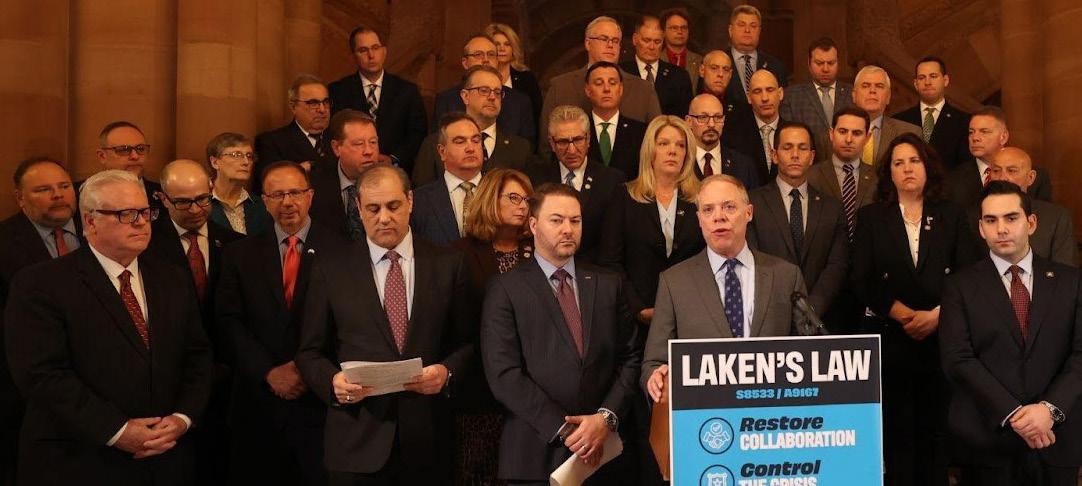



Women’s History Month is a celebration of women’s contributions to history, culture and society and has been observed annually in the month of March in the United States since 1987. Women’s History Month 2024 will take place from Friday, March 1 to Sunday, March 31, 2024.
This month, we remember:
Lake Ronkonkoma Equal Rights Suffrage Club 1912
The Club was organized in September 1912 by Miss Harriet May Mills of New York City. The first speaker was Miss Cora Morlan.
Our own Lillian Devere with the help of Rosalie Gardiner Jones, had The Suffrage Club up and running in no time. The early meetings were engaged at Mr. Fisk’s Ice Cream Parlor on Pond Road & Church Street. The meetings would determine and plan the next events.



SATURDAY, MARCH 9, 1:00 P.M.
“Women in Long Island’s Past,” at the Long Beach Library
TUESDAY, MARCH 12, 1:00 P.M.
“Long Island’s Early Women Aviators”, at the South Country Library in Bellport with Natalie Naylor.
WEDNESDAY, MARCH 13, 2:00 P.M.
“Women in Long Island’s Past,” at the Women’s Club of Massapequa at the Massapequa Bar Harbor Library with Natalie Naylor.
WEDNESDAY, MARCH 20, 1:00P.M.
“Long Island’s Early Women Aviators” at the Lindenhurst Library with Natalie Naylor.
WEEKENDS MARCH AND APRIL:
Tricia Foley of new exhibit, “Women Who Made a Difference: Local Women’s Rights Advocates and Their Stories”, at the Bellport-Brookhaven Historical Society 12 Bell Street, Bellport. (631) 286-0888
THURSDAY MARCH 21, 7:00P.M.
Bay Shore Historical Society at the Bay Shore-Brightwaters Public Library (1 South Country Road, Brightwaters). “Ladies First-Common Threads” handcrafts book discussion with author Debra Scala Giokas.

Euchre and Dance events were held at the Fire Hall, and were successful including refreshments, music, and dancing. Rosalie Gardiner Jones and other ardent leaders would meet at the Devere home and picnic followed by a swim in Lake Ronkonkoma. They took their part in the Riverhead rallies and in local parades and events, bringing support to their cause with great style. Locally, they had booths at Athletic Meets on Declaration Day, Independence Day, and Labor Day bringing the total to about eighteen dollars’ worth of Suffrage flags and novelties. On July 4, 1912, the Club joined the Parade with Miss Rosalie Gardiner Jones hiking along a decorated automobile with Suffrage flags. Expected to meet here in Lake Ronkonkoma, Mrs. Kearns and Miss Welch of New York riding in the decorated wagon pulled by a horse. Unfortunately, the horse would not make the trip, which allowed them to campaign at Long Beach.
The Equal Franchise Society, in 1914, sent eighteen books that circulated in our area and started the quest for our own library. Lillian Devere mobilized local women into a suffrage group to win the vote and made huge strides that helped the entire community.

Newspaper article July 6, 1913
Perhaps the highest honor the Club held was leading the Torchlight Parade which began at Fifty-Eighth Street and Fifth Avenue, Manhattan in 1912.
If you care for additional information regarding Suffrage in Lake Ronkonkoma or have information on a Suffrage member, please contact us.
“You must never be fearful about what you are doing when it is right.”
– Rosa Parks (1913-2005) civil rights activist.
“The way to right wrongs is to turn the light of truth upon them.”
– Ida B. Wells.


If there is anything I have learned throughout my time in politics is that numbers do not lie and what we have seen on Super Tuesday 2024 are two important takeaways: Republicans are uniting behind Donald Trump and Joe Biden has a serious problem with the growing number of ‘Uncommitted’ voters.
The major concerning factor for Joe Biden among these ‘Uncommitted’ voters is that a number of these voters are from his own party, showing that his support among Democrat voters is eroding.
Voters are rejecting the failed policies of the Biden administration which have given us an open border and a historic migrant crisis in our country, surging crime rates, and record inflation.
Donald Trump is the clear winner tonight. His victories across the board on Super Tuesday show that Republicans are rallying around his agenda of putting America First, both at home and abroad, securing the border, and making our
economy as strong as it once was under his leadership as President.
There is no doubt that tonight’s strong showing for Donald Trump is a message for November and that is American voters are ready to put back a real leader in the White House.
Chairman Jesse Garcia is the chair of the Suffolk County GOP and the Brookhaven Town GOP.





President Trump was already off to a historic start in the race by setting primary voting records in Iowa, New Hampshire, South Carolina, and Michigan prior to yesterday’s results. But his near perfect Super Tuesday performance elevated his historic primary to an even more legendary status, as those four states were joined by Alabama, Arkansas, Alaska, Colorado, Maine, North Carolina, Oklahoma, Tennessee, Texas, and Virginia in setting record highs for primary votes.
Of course, this primary has been expounded on by figureheads with clear political biases on network television, making it difficult to truly understand what the results mean in terms of candidate strength. But the following chart, whose figures were retrieved from uselectionatlas.org, which show states where Trump has set primary records thus far compared to the previous record, objectively illustrate a truly historic performance for Trump as a non-incumbent candidate.
The chart does not mention the 98 percent of overall counties Trump has won, which demonstrates far reaching support beyond just densely populated areas. However, because it is Trump choreographing this historic run, it continues to be misconstrued by mainstream media and bitter primary opponents.
For example, no candidate in the history of the Iowa Caucuses ever won by greater than a 12 percent margin, or even came close to securing greater than 50 percent of the vote, a majority. But this year, in addition to winning all but one county (which he only lost by one single vote), Trump finished with 51 percent of the vote, and won by a nearly 30 percent margin.
Yet despite this historic performance, Ron DeSantis – who visited all of Iowa’s 99 counties alongside Governor Kim Reynolds only to finish in a very distant second – claimed if Ronald Reagan were running for a third time, he would have received 85-90 percent of the Iowa vote in an attempt to downplay Trump’s popularity. Beyond ignoring the above figures proving Trump’s dominance, the only somewhat available metric to test DeSantis’ claims would be the 1988 Republican primary, where Reagan’s Vice President, George H.W. Bush came in FOURTH place in Iowa, weakening his hypothetical theory.
Nikki Haley has been even more extreme in misconstruing data. Following each loss, Haley makes the claim that almost half (subtly conceding a minority) of REPUBLICANS prefer someone other than Trump. Yet she fails to ever mention the fact that her already low numbers are boosted by Democrat voters voting for her.
For example, following her blowout loss in New Hampshire, it was revealed that an estimated 70 percent of her votes came from non-Republicans. Likewise, in her home state of South Carolina, where theoretically she should be at her most popular, it is estimated that 19 percent of her voters identified as Democrats.
When removing non-Republican voters from Haley’s count and the overall figure in these states, Trump’s victory in New Hampshire shifts from 54%-43%, an 11 percent margin of victory, to a whopping 79%19%, which is a 50 percent margin of victory. In South Carolina, the margin shifts from 60%-40%, 20 percent in favor of Trump, to 65%-35%, or 30 percent in his favor. Both adjusted figures much more accurately represent voter sentiment amongst actual Republican voters in these states and debunk Haley’s claims about a divided party.
Less surprising has been mainstream media’s attempts to diminish Trump’s increasing popularity. MSNBC’s Lawrence O’Donnell claimed South Carolina’s results were “disastrous for Donald Trump.” This is outright laughable considering he secured almost 150 THOUSAND more votes than the previous primary record in the state, while running against someone who previously served as its governor who benefitted from an influx of Democrat voters.
Across the political aisle on (allegedly) right wing networks like Fox News, network mainstays such as Karl Rove suggest results in certain states signal a divided
Republican party. Rove also warns that Trump may struggle to win over voters, while also aligning himself with Haley by foregoing mention of the Democrat voter influx or Trump’s historic polling inroads with minority communities.
If one is not convinced by the above figures, there is one other reference point in history to draw on where a former president sought a non-consecutive term, which was President Grover Cleveland in 1892. Trump, just like Cleveland, was previously president, but is not currently an incumbent. That makes this a contested primary, where due to numerous candidates running, no given candidate will be able to secure the close to 100 percent vote total that true incumbents receive during a reelection primary while in office. And while all aspects of life have changed since this last occurred roughly 130 years ago, it is worth
noting Cleveland received just two-thirds of his party’s delegates at the Democrat convention and still went on to winning the presidency. In contrast, as it stands today, Trump has secured 91 percent of delegates, a figure that is expected to increase.
Having different political opinions or candidate preferences is perfectly acceptable. But the comparing of apples to oranges, and the omission or cherry-picking of other data from all directions gives off the perception of coordinated bitterness as opposed to objective analysis when you consider all information mentioned here is widely available.
So in conclusion; the numbers, projections, and even a little bit of history all point to this being a historic display of dominance for President Trump. It is expected that by March 19th the latest, he will have surpassed the necessary 1,215 delegates to secure his third Republican nomination. While we will never know whether DeSantis was right about a potential Reagan 88’ performance, if his 85-90 percent baseline popularity figure is true, in terms of counties (98%), states (96%), and the all-important delegate count (91%), it seems Trump is well on his way to achieving that.







Origin:
late 17th century: from Latin paenultimus, from paene ‘almost’ + ultimus ‘last’, on the pattern of ultimate.
Source: Oxford Languages
Synonyms: succeeding, closing
Adjective
Pronounced: pih-NUL-tuh-mut
Definition: second-to-last in a series
Example: Example: “The penultimate novel in the series set the stage for an enthralling finale.”
Antonyms: first, beginning


The aim of the game is to get from the given initial word to the given final word by changing only one letter per line. Note that every line must be a valid word. Sometimes there are several possibilities.
Initial word: FOUR
Final word: FIVE
Goal: 8 words
Check our Instagram @MessengerPapers and our Facebook for the answers to this week’s games.





March 8, 1894
March 9, 1959
Barbie makes her debut at the American Toy Fair in New York, leaving a legacy of over a billion sold dolls in 250 careers not including the many themes some career dolls have been released in, over 40 animated Barbie movies, shows, and video games, and one life-form movie which has grossed over one billion dollars at the box office.
The state of New York enacts the nation’s first dog-licensing law, ensuring any dog over the age of 4 months is registered with a license proving rabies vaccination and status of neutered or spayed.


March 13, 1852
Uncle Sam cartoon figure made its debut in the New York Lantern weekly. It gained country-wide recognition after being the center of World War I and II recruitment posters, which was modeled by a true US. Veteran Walter Botts.
Notice of Adoption of Resolution
Subject to Permissive Referendum
Farmingville Fire District
Town of Brookhaven, Suffolk County, NY
PLEASE TAKE NOTICE that at a meeting of the Board of Fire Commissioners of the Farmingville Fire District held on February 26, 2024 the following Resolution subject to permissive referendum PR2024-2 was adopted: The Resolution authorizes the purchase of a Gear Washer and Dryer, with necessary and related equipment, and the expenditure for such purchase and installation not to exceed $40,000.00 from monies now in the Equipment Reserve Fund of the Farmingville Fire District heretofore previously established.
Dated: February 28, 2024
BY ORDER OF THE
BOARD OF FIRE COMMISSIONERS
FARMINGVILE FIRE DISTRICT
Nicolette Laccesaglia, District Secretary 5175 B 03-07-24



John Corral, Environmental Projects Coordinator






meeting to the attention of:











Assemblyman Joe DeStefano (R,C-Medford) attended a press conference in the New York state Capitol to support his colleagues’ bipartisan push to pass “Melanie’s Law” (A.6026/S.6288), allowing courts to issue orders of protection for immediate family members or household members of victims of domestic violence, regardless of age. The press conference was led by Assemblyman Anil Beephan (R,C-East Fishkill), Assemblyman Brian Cunningham (D-Brooklyn), Senator Rob Rolison (R-Poughkeepsie), Senator Michelle Hinchey (D-Saugherties), and Cheryl Chianese, Melanie’s mother, who joined together to call for the law’s immediate passage.
Melanie Chianese’s life was tragically taken by her mother’s ex-boyfriend while he was under supervised release pending sentencing after pleading guilty to a domestic violence felony. Melanie’s Law closes a loophole in anti-domestic violence legislation to include persons related “by consanguinity or affinity to parties who are or have been in, on the order of protection.”
“We continue to advocate for Melanie’s Law because it has not yet passed, a true disservice to those it could shield from harm,” said DeStefano. “Essential to combating domestic violence, Melanie’s Law stands as a crucial measure. The tragic loss of Melanie Chianese, a young mother herself, at the hands of her mother’s ex-boyfriend, underscores the urgency. Her exclusion from her mother’s protection order solely based on her age of 29 highlights the flaw that could have been prevented with a more inclusive law. While we cannot bring back Melanie, we can honor her memory by safeguarding others. Domestic violence often extends beyond the immediate parties involved, impacting children, parents and even pets
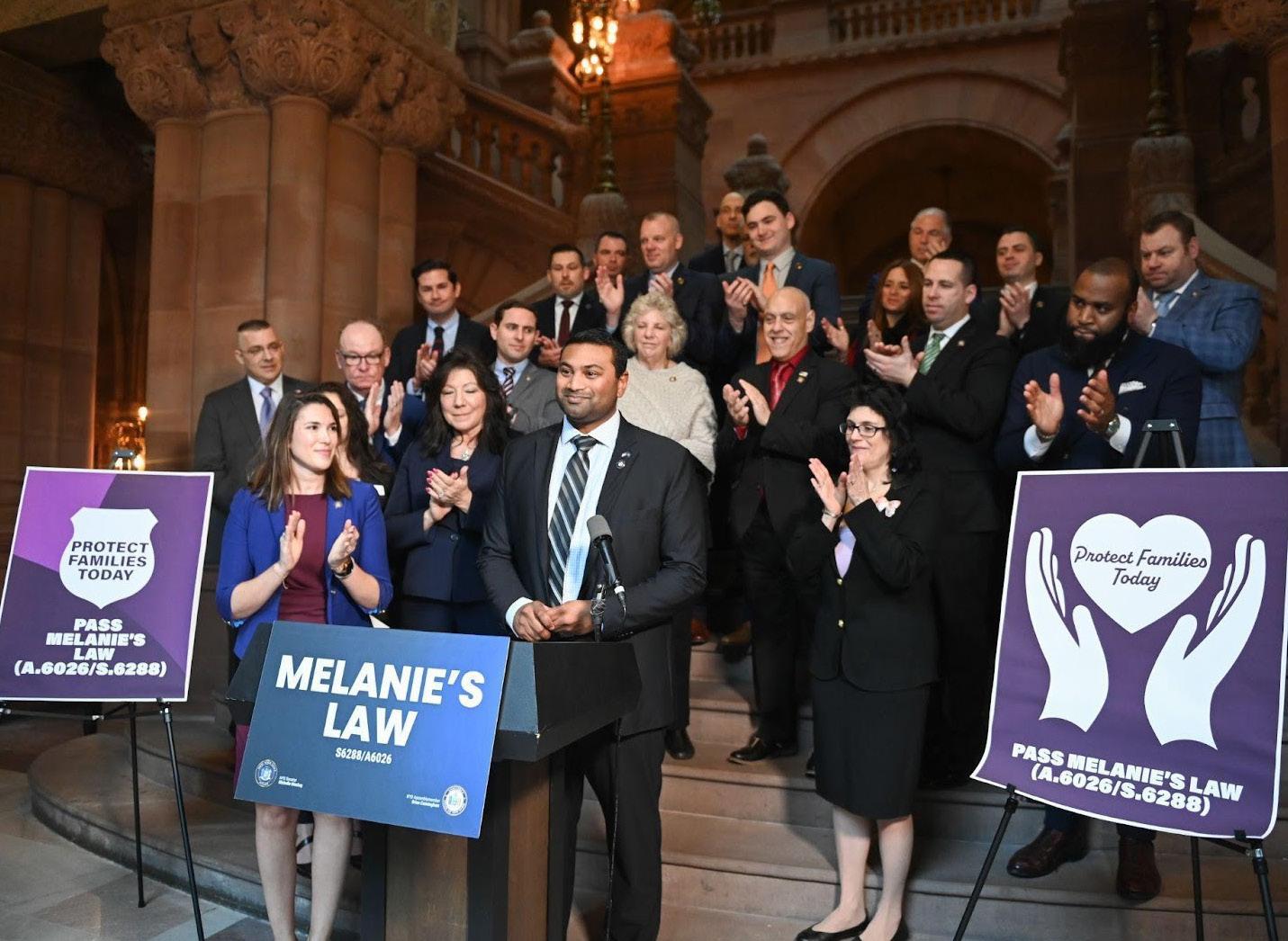
as abusers seek to instill fear into their victims. As state leaders, we have the power to put an end to this. I am once again proud to lend my support to Melanie’s Law alongside my colleagues. The time for delaying this crucial legislation is over—it must be enacted without further delay.”

Assemblyman Joe DeStefano (R-Medford) represents the Third Assembly District, which consists of Bellport, Brookhaven hamlet, Mastic, Mastic Beach, Medford, North Bellport, Shirley, Yaphank, and parts of Farmingville, Holtsville, Middle Island, North Patchogue, Ridge, and Upton. For more information, please visit: nyassembly.gov/mem/Joe-DeStefano/
Assemblyman Ed Flood (R,C-Port Jefferson Station) attended a press conference to advocate for “Melanie’s Law” (A.6026/S.6288), a measure that would extend orders of protection for family members beyond the individuals named in them and to minors in the family, regardless of their age.
Melanie Chianese was a resident of Wappinger, New York when her life was tragically taken by her mother’s ex-boyfriend while he was under supervised release pending sentence, later pleading guilty to a domestic violence felony. Because Melanie did not have a direct relationship with the perpetrator, she was denied an order of protection. This act is named after Melanie to honor her passion for helping others during her life in hopes that her story can inspire needed change and save lives.
“It is admirable to see Melanie’s mother stand with me and my colleagues to fight for a change in our criminal justice system,” said Flood. “Her mother
standing with us brings back emotions and memories, yet she continues to advocate and pursue her wishes to make a difference. I urge the Legislature to push this proposal through the legislative process quickly so Melanie’s Law can help save lives.”
Assemblyman Ed Flood Represents the Fourth Assembly District, which includes Belle Terre, Coram, East Setauket, Gordon Heights, Old Field, Poquott, Port Jefferson, Port Jefferson Station, Setauket, Stony Brook, Strongs Neck, and Terryville, and parts of Centereach, Lake Grove, and Selden.
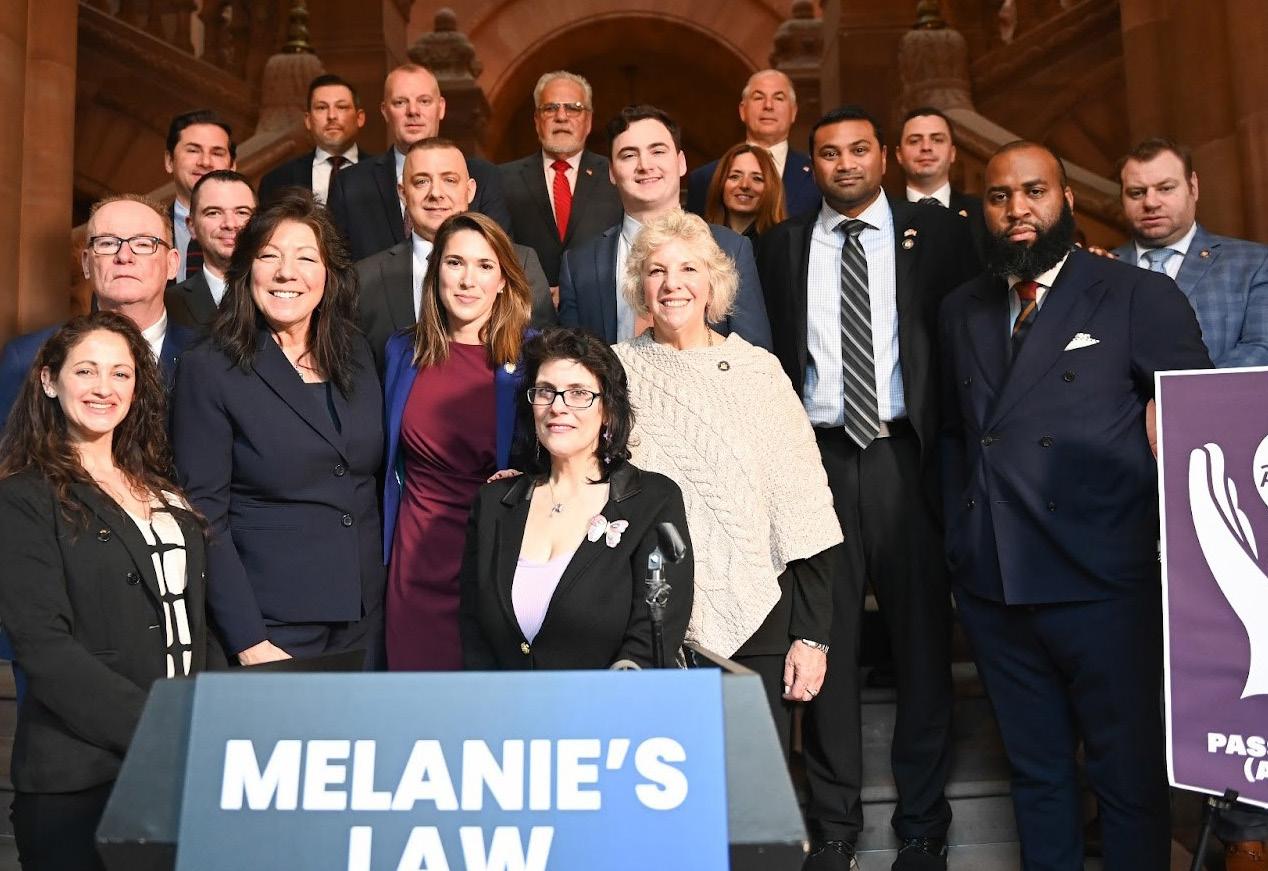

The stage was perfectly set for the Suffolk County game of the year. Both teams were previously undefeated with 22 wins and no losses. The gym was packed with nearly 3,000 fans and standing room only. Tensions were high in the building as the student sections from each district were already chanting back and forth twenty minutes prior to tip off. The two top ranked teams in the county were finally going to face off in game that has been talked about before this season even began.
The Bayshore Marauders, led by 6’6 forward Christian Smiley, came out on fire in the first quarter. Their tough zone defense clogged up the paint and caused the Colonials to turn the ball over several times, turnovers that Bayshore capitalized on one after another. They went on a twenty-two-point unanswered run against the Colonials which they had trouble fully coming back from. The score at halftime was 31-9 with Bayshore on top.
William Floyd did come out to battle back in the second half though. Floyd’s guards Joey McLaurin and Jermaine King took control of the game in the third quarter. At one point in the third, the Colonials pulled within eight points of Bayshore which also set the Floyd crowd a blaze. Tashawn Bumpers

and Khamari Broomfield had several answers for their run, which kept Floyd at bay.
The fourth quarter was a constant back and forth show in which Bayshore was able to hold William Floyd with enough of a distance to win by a score of 65-59. Bayshore won their first Suffolk County large school championship since 2004. They improved to 23-0 while William Floyd’s season came to an abrupt end at 22-1. Bayshore goes on to the regional Long Island Championship this upcoming Saturday, March 9, at Farmingdale State college at 5:00p.m. They will take on the large school champion of Nassau County, the Baldwin Bruins.
The Messenger would like to mention the admirable display of sportsmanship after this game specifically. While a few of the Floyd seniors were visibly upset about the season and career ending loss, Christian Smiley and a few other Bayshore players consoled them before celebrating with their team. These young men showed integrity and character to their opponents this evening, with whom they also play on some of the same teams in the summer Amateur Athletic Union (AAU) League. We commend you young men, best of luck this Saturday!


 By Diane Caudullo
By Diane Caudullo
Commander Bob Holecek of the local American Legion graciously stopped by The Messenger Papers office with some of his board members to present a certificate to our Newspaper. Fred Tartaglione, 2nd Vice Commander, and Paul Attard, Director, joined him. They came to show their appreciation to the newspaper for our advertisements for them and a few other Veteran Organizations free of charge. Our newspaper is happy to do this since we appreciate our great Veterans.
Between the three of them, they represented the Air Force (Holecek), the Navy (Tartaglione), and the Army (Attard). Paul Attard, the eldest of them, now 93, served during the Korean War. Bob Holecek’s service-turned-career spanned from Vietnam through the Gulf War, and Fred Trataglione, the Vietnam War.
These men and the many members of their American Legion, named William Merritt Hallock Post 155, Lake Ronkonkoma, served us heroically then and continue to serve each other, the many Veterans that came after them, and their community to this day.
See the QR code at bottom right to access this all too important site and information. This is information that needs to be widespread preemptive of an issue where it may be needed. Often, a Veteran will suffer in silence and then it is too late to help.They need to know now that this is available to them.

In keeping with American patriotic traditions, this American Legion will host their Memorial Day Parade on Monday, May 27. They will host an event about flag protocol: holding, folding, and properly retiring a flag on Flag Day, June 14.
You will often see them at street fairs and festivals, offering a small red Poppy Flower in exchange for a donation. The Poppy came to be the symbol of support and respect for the fallen Veterans which originated from a poem called “In Flanders Fields” in 1915, by Lieutenant Colonel John McCrae. The Messenger will cover this in further detail closer to Memorial Day.

Many people know that the halls that are for rent, which this one is, and the social functions and camaraderie that are a component of these organizations, but there is so much more.
Seemingly most important to me is that they are there to help other Veterans, whether they are a member or not, and the families of Veterans through tougher times. Once a Veteran, always a Veteran - and Veteran life comes with some additional issues that only a servicemember can truly understand. The members help others with educating others about the benefits for which they are eligible and assist in the sometimes daunting paperwork and processes to get them. They assist in financial hardship or illness and are a wealth of information on the resources out there for various situations a Veteran may face. Most worth mentioning is the “Be The One” program. This is a crisis hotline and members from within the post will walk alongside the Veteran in need.
The American Legion’s membership is open to all who have served in any branch, at any time, having served our country honorably. They currently have Veterans of all ages and varied experiences. Amongst them are two Veterans from World War II. Much of their good work does depend on donations and revenue from renting the hall. The membership and board members are all volunteers. They are currently forming a committee to send young people to what is known as Boys State and Girls State. It is for boys and girls interested in learning more about the government. It is a week-long trip

where they participate in mock legislative sessions, mock court proceedings, enjoy assemblies, and discussions and recreational activities. The American Legion Post and local businesses help to sponsor the students who are selected to go.
American Legion Post 155 is actively seeking new members to join them.
To learn more about this American Legion, located at 115 Church Street, you can call 631-565-9822.
Scan this QR code for the “Be the One’’ program and the Veterans Crisis Line.
Dial 988 and then press 1.
